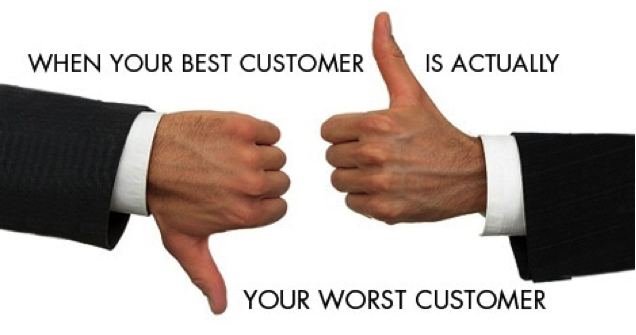Nov 8, 2016 | Customers, Marketing
 How your competitors are getting ahead.
How your competitors are getting ahead.
Every business has its competitors. And while market analysis isn’t exactly a new practice, markets for any product or service are becoming increasingly competitive. Today’s key players are constantly hunting for ways to fine-tune their intel. If you’re already on top of knowing your competitors, great, but the thing is, instead of turning only to who you’re competing with, don’t forget to also focus on who you’re competing for.
As a small business owner, you are aware of the competitors in your local marketplace, but what about online? During the buyer’s journey (the marketing funnel), potential customers are looking to your website for education on your products or services. In fact, 97% of consumers use online media when researching their local market (1). Because of this situation, businesses no longer control the selling process — buyers do.
Your company’s website is a key factor to converting leads. In order to maximize its full potential, you’ll need to assess how your marketing efforts are stacking up against your competitors. Keep reading to learn the key steps to conducting a market analysis, putting you two moves ahead of your competitors.
Identifying multi-level competitors
When you’re a small business, you might consider the obvious multi-million company as your competitor. In this step, choose your top three competitors on a local level, a regional level, and a national scale. Also consider other alternatives your customers could buy instead, products from companies that are indirect competitors. Acting as a starting point, this helps you narrow your audience, working your way outwards.
Drawing in your target audience
It’s one thing to speak loudly, it’s another for people to listen. Trends are showing that audiences are less likely to respond to salesy ads and traditional banners. Instead, opt for a genuine relationship with your customers, one that you nurture over time. You can do this through high-value content, give away resources (such as how-to guides), and social media. You have to give before you can get.
Assessing your website conversions
Your website is pretty, but is it bringing in numbers? Do you consistently look at your analytics data, do you see patterns? If your page loads too slowly, or your search terms are misleading, you may have a high bounce rate. If you’re providing great blogs, your click-through rate is fantastic, but are you asking them to take a specific action? The answers are all there in the stats. Next, you’ll want to take a look at the overall growth and measure it side-by-side with your revenue. Customers are actively looking for value, especially online. How well are you positioning them with the content you’re providing?
Considering industry trends
The world is changing every day, the same pertains to technology. With Google and Facebook accounting for 76% of internet advertising growth this past year, it’s wise to incorporate trending factors into your strategy. Mobile is exploding and visual engagement continues to excel. Opt for stunning visuals with value-rich content to gain the attention of customers.
Identifying areas of improvement
Are you blogging at least once a week? When was the last time you updated your website content? Always be looking for areas to improve. As you bring in customers, ask how they found you. If online, dig a little deeper and find out where. We highly recommend performing a quarterly marketing analysis to identify strengths and hurdles, project trends, and adapt your plan of action.
How do you use market analysis to steer your advertising efforts? Share your ideas with us.
Aug 10, 2016 | Customers, Sales
The sales pitch of the past isn’t effective in today’s marketplace. Today, a sales pitch is a two-way conversation. You ask good questions and listen to the buyer. The buyer has the opportunity to ask questions, and in the process they’re able to develop a much more personalized relationship with you, and your product or service. Captivating your audience lies in the details. From relevant buyer information to interaction and negotiation, these seven tips will help you nail your next ‘sales pitch’.
- Preparation
Successfully connecting with your audience involves preparing yourself with relevant buyer information. Prior to the presentation, conduct in-depth research on the buyer’s company, industry, and competitors. Include social media in your search. This will allow to tailor your message, better communicating how you can meet their specific needs.
- Emotion
Drawing on emotion is critical in sales. Highlight the unique challenges of the business you’re talking to and allow them to visualize your product or service as the solution. Most often people react and make buying decisions emotionally first then rationalize with information. Having a compelling story backed by facts is a force to be reckoned with.
- Confidence
Not only is it important to be prepared and leverage emotion, but also to bring confidence to the presentation. Promoting yourself as an industry leader or savvy entrepreneur subconsciously builds credibility with your audience. You can achieve this by sharing stories about your dedication and vision for their initiatives or stories about how you helped other customers.
- Interaction
Even if you are presenting detailed information, you must read your audience during the sales pitch. After all, it’s a two-way conversation. Gone are the days of PowerPoint slides and bullet points. Today’s most successful pitches include choices, audience interaction with products and services, and being prepared for any questions the buyer may have.
- Objection
As mentioned, the buyer will most likely have questions. The most common objects during sales pitches fall under budget, authority, need, and time. Be prepared to go into your presentation with responses to all four. The goal is to have answers prepared, making you appear more knowledgeable while increasing your product or service’s value.
- Negotiation
The negotiation portion of a business pitch can be intimidating. Before pitching, have a plan in place for negotiation. Not only should you be familiar with what you’re offering, but research how your audience members have invested in the past. Have a plan for the best case, the second best, and the worst. Add value before discounting price. This will help you approach your presentation prepared for any response.
- Confirmation
Always end your sales pitch with a call to action. If a negotiation isn’t instantaneous, be sure to include a specific follow-up plan. That communication touch point in the sales funnel will keep you on the radar, placing you in a good position for future prospecting. Follow-up meetings and trials are great ways to keep your audience engaged going forward.
Now that you’ve journeyed through our seven steps for a flawless sales pitch, we hope you feel more confident in putting your skills to the test. Knowing your buyer, product or service, showing a genuine interest in providing a solution, and being prepared for any objections will allow you to present your next business initiative with ease.
Need more?
Aug 26, 2015 | Customers, Leadership
CRM, Customer relationship management is a key to long-term success that successful business owners actively pursue, and continually improve. A good customer relationship management strategy will help to increase your sales while ensuring that your store or business has a repeat and loyal clientele that will generate long-term profitability.
This can only happen if the employees, who work for you, are well-trained and follow your customer retention program when it comes to the organization’s customer relationship culture. You can achieve this by:
- Develop your customer relationship/ retention program (you have one right?)
- Allocate part of your marketing budget to CRM/retention
- Develop a set of KPIs (Key Performance Indicators) to provide benchmarks for your team to meet on customer satisfaction and measure it frequently.
- Develop a training program and provide ongoing training in areas that are important when it comes to delivering an exceptional personal service –
- Reinforcing existing skills with systematic, ongoing feedback and coaching
- Rewarding their performance through a combination of recognition and monetary awards
Working on Continuous Improvement
When it comes to running a service oriented business, a number of things can go wrong in a single day. Your products and services were faulty, resulting in customers becoming frustrated and demanding a refund, or some other compensation. In such a scenario, organizations that are efficient at ‘recovery’ will be able to resolve such issues. For this, you will have to:
- Ask for complaints and customer feedback, directly from the source and often
- Take ownership when something goes wrong, acknowledge the customer’s feelings of frustration
- Provide effective training to staff when it comes to handling customer complaints
- Train your staff on DISC and how to communicate with frustrated customers
- Actively work on solving the core issue to eliminate reoccurring issues
- Focus on prevention as well as effective problem solving when it comes to issues
Ensuring Managers are the Key Change-Agents
An effective customer relationship management strategy can only be derived if the middle management i.e. the managers of your store, office, or production area are actively involved in the change process. Your managers have the power to make or break your business; therefore it’s very important to:
- Inform the management team regarding the situation immediately
- Give them tools required so that they can articulate customer experience strategies as well
- Provide effective training to managers so that they are an example to the people under them
- Give reward to managers when it comes to monitoring, establishing and upgrading the service delivery process.
For more on developing an effective CRM and improving customer retention, feel free to get in touch.
Feb 17, 2015 | Customers, Systems, Uncategorized

How to Keep Your Customers Coming Back
So we’re on step 4 this week of reviewing the 5 Steps to Increased Profits framework – focusing on one of the five steps each week. As a review, the five key profit-generating metrics are: Lead Generation, Conversion Rate, Average Dollar Sale, Number of Transactions, and Profit Margins.
I’ve highlighted the five keys in the following equation:
Lead Generation
x
Conversion Rate
=
# Customers
x
Avg. Dollar Sale
x
Avg. # Transactions
=
Revenues
x
Profit Margins
=
Profits
I talked last post about the importance of ensuring you boost your Average Dollar value of each sale. This week we focus on increasing Number of Transactions by looking at how to keep customers coming back. Many businesses think that once they have a new customer, the work is over, but in fact the work has only just begun!
When a prospect buys from you for the first time, they step on to the first rung of what we call the “ladder of loyalty” and become a shopper. Then when they buy again they take the next step and become a customer, and so on up the ladder, as can be seen in the following diagram. The framework to keep customers coming back and generating Repeat Business, is to increase lifetime value by using the 7 rungs of the Ladder of Loyalty:
| RAVING FAN |
| ADVOCATE |
| MEMBER |
| CUSTOMER |
| SHOPPER |
| PROSPECT |
| SUSPECT |
On the lower levels of the ladder, there is very little customer loyalty and if a competitor comes along with a better price, customers are more than likely to give them a try, and you may never see that customer again. The art of achieving a high level of customer loyalty is to move them further up the ladder, so that they become loyal clients and eventually raving fans. Once they become a raving fan, not only can you guarantee they will always buy from you, but they will go a stage further and start actively recommending other people to come to you, so helping to fill your sales pipeline.
So how do you turn your customers into raving fans? Well, the first stage is to know who your customers are and categorize them based on how much they spend with you and how much of your time they take up. I use an ABCD system:
A = Awesome
B = Basically sound
C = Could do better
D = Don’t want to deal with
There is little point in spending time and effort with your D clients. These are the ones that haggle over price, take up your time over pointless queries and spend so little with you compared to the effort you put in that if you checked, you’d probably find that they bring you no profit at all. So just pass them on to one of your competitors; you never know, they might become their awesome clients!
C clients are those that have not yet been educated in how you like to do businesses. They have some of D’s habits, but buy sufficiently from you that they are worth trying to upgrade.
B’s are the clients who form the bread and butter of your business. Some you will be able to upgrade but others will need more attention and appreciation to maintain their loyalty
A’s are your advocates and raving fans. These guys make what you do enjoyable. They not only buy from you but they can’t wait to tell others about you.
So what do you do to upgrade and maintain your clients at the appropriate level? Well, the answer is simple. You keep in contact with them and create a loyalty program. There are many ways that you can keep in contact with your customers, and technology has made this far easier than ever before. Through email, blogging and social media, you can remain in contact with your customers as regularly as you like for the minimum of investment.
The more traditional method of keeping in touch with your customers include telephone calls, newsletters, direct mail and entertaining. Whichever method you use, you must bear in mind the appropriateness of the medium and its effectiveness and importantly, make sure that you give value to the customer.
The easiest method to set up and systemized is the quarterly newsletter or email. Some people dislike newsletters because they are full of dull boring information about the company, which is of no benefit to them. So the best way to appeal to people is to be more creative and have some fun with it and provide high value content. People like to be informed of interesting things, learn something new and have fun. With some thought and creativity, you can make receiving your newsletter a highlight of your customers’ quarter.
Loyalty schemes there are some very simple schemes you can use that will have just as much effect as the big airlines programs. All you have to do is monitor the level of business a client does and then reward them when they hit certain targets. You can do this via databases, accounts systems or plain and simple printed cards. Rewards need not be money off; in fact you can get really creative with this – all you have to do is give perceived value.
One great strategy is to find a non competing business in the same sector and offer each other’s clients something from your range, e.g. a photographer and a florist could swap a bouquet for a portrait. Remember that this will have the added advantage of putting a new person onto each other’s loyalty ladder.
Another great way to reward loyalty is to invite clients to a special event, such as an educational seminar, a new season products launch or even arrange a celebrity visit.
Whatever you do to keep your clients coming back and stepping up the ladder, make it interesting, add value to your clients’ lives, have some FUN, but above all, TAKE ACTION.
Dec 1, 2014 | Customers, Marketing

Converting leads into customers – One of the biggest tragedies I see in business is watching a business owner spend significant time and effort generating leads for their business, but then not acting on them in a logical, methodical, repeatable way to convert those leads into paying customers.
You haven’t done that in your business have you? But I’ll bet you know someone (better to keep them nameless) who has a stack of business cards on their desk that they have collected through their networking activities but they have not been added to their customer database, no follow-up has taken place, and they are essentially growing colder by the day. If that is you, no need to raise your hand. But it is time to get out of the trap and start turning those leads into paying customers, wouldn’t you agree?
To make improvements in this area, you simply have to start doing one thing – MEASURE your current conversion success rate! Most business owners have no clue what their conversion rate is. By simply measuring where you are, you will improve. It happens every time. Once you start measuring, you realize what you should be doing that you are not, and your results begin to improve.
Add to that a specific, focused approach to handling your leads and your conversion rate will go through the roof! And, the best part is, you can grow your business without spending one more dollar! You’ve already invested marketing dollars to generate the leads. Now, make the most of that investment by defining your specific, repeatable sales steps that will convert your leads into customers.
To get started, take a few minutes and write down the specific steps that you take each and every lead through to get them familiar with you and your business. Each business has a different set of steps in their selling process. Some have just a few steps, most often where the average ticket price for a transaction is relatively small. Others have many steps, most often where the average ticket price is relatively large. You must decide how familiar a new prospect needs to be with you and your business in order to pull out their wallet and make a purchase. If it is a complicated product or service, you will likely need more steps in your selling process.
Once you have your current process steps written down, ask yourself, is everyone in my business doing it the same way? If not, why not? How can you have a “best in class” approach if you allow each individual to “roll their own”? How can you test and measure new approaches if you don’t first start with a standard? How can you improve and predict your outcome if there are multiple approaches? The answer to all of these questions is you cannot!
I often hear business owners say they would lose their best sales person if they made them follow a standard sales process. Let me ask you – whose business it? Is it yours’ or your sales person’s? Who has all the risk in the deal? Who is setting the expectations and limitations? My hope is that it is you – the business owner. Don’t let the personal preferences of others dictate how you will run your business – unless you like working for them!
Establish your specific selling process steps, train your team to follow the selling process, support it with the necessary materials, and measure the results of each specific step. Make changes to your sales process based on the results of your measurements. Test and Measure. Test and Measure. Again and again. Make incremental improvements and hold yourself and your team accountable for the results. This is the recipe for success.
One last thought. As you build your step by step sales process, be mindful of the thought that in every sales process there is a point where your prospect will do some specific physical something to indicate they are ready to buy. If you can identify that “physical something” for your business, then point all of your efforts to make that happen, your conversion rate will improve. I call this the “get on the boat” moment. One of our clients has a 100 person catamaran on a local lake and does corporate events, private parties, wedding, etc. His specific physical something for his prospects is to get them to step foot on his boat. Once they do that, they are so impressed that they are very likely to sign a contract. What is your “get on the boat” moment?
Stay focused. Stay determined. Be determined. Build a repeatable process for converting leads into customers. Your business success will become a certainty.
Nov 24, 2014 | Customers

Are they your best customer or worst customer?
You know who I’m talking about. That one customer who is seen as the most important and precious to the company, who everyone treats with kid’s gloves. Yet this customer seemingly pays later than all the others, demands special terms, takes up a great deal of the manager and staff’s time and never seems satisfied?
When I ask business owners about why it is that one customer can seem to dominate their company, the reply is often along the lines of, “they’re our longest-serving customer” or, “they’re our biggest customer” or even “they’re a personal friend of the owner”.
In this situation, it’s useful to ask: is this customer adding to the long-term growth and well-being of the firm or, actually detracting from it? This situation is particularly acute when that one customer’s business represents greater than 40% of the overall revenue. This benchmark indicates that the customer has too much influence, and in effect, it runs the business, not the owner.
For a small to medium enterprise, accepting those large orders seem critical to growth, but at the same time betting the business growth on the back of one customer places the businesses into a very dangerous position. I’ve both been in a business where this has been the case and worked with clients in this position. The key point to watch out for is that if this large customer starts to dictate how your business operates, what markets it is in, what products it offers and then, on top of that, chronically pays late, then the business owner can get into real trouble.
How to get out of this? In the short-term, work on educating the customer about the terms of business you want to have with them. Easier said than done you may say, yet when explaining what you want, what your business needs in order to continue being a stable supplier for them, and why the modifications to your existing arrangements are necessary for the relationship to remain valuable for both of you, often will produce the change you’re looking for.
In the long-term, work towards expanding your customer base and even, towards firing that one customer if desired or necessary for you to meet your long-term goals for the business. Again if a customer doesn’t pay on time, or exerts too much control over your business, no matter what their size, are they really a customer you want? And how much time could be freed up to handle those that do pay with better margins? Remembering to work this plan in alternative customer sources and cutting of ties when the time is right for you.
In ActionCOACH we call this getting rid of ‘D’ Class customers (we grade all customers A to D). Get rid of your “D”s, so that you have more time to cultivate your “A”s. Go over your whole customer list. Does your ‘best’ customer upon inspection really live up to this premise – or if you had a choice, you’d rather not to have taken the order and would prefer to have other customers?




